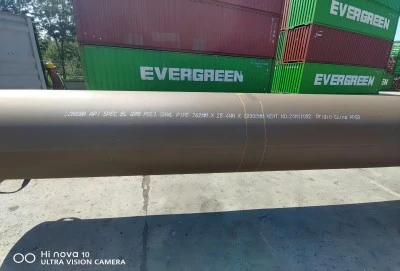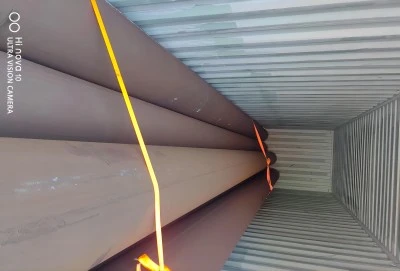Welded steel pipe is indeed allowed for drainage in many applications, particularly in industrial and large-scale projects. Its use in drainage systems depends on various factors, including local building codes, environmental regulations, and specific project requirements. Welded pipes offer exceptional strength and durability, making them suitable for high-pressure drainage systems in oil and gas facilities, water treatment plants, and large industrial complexes. However, their appropriateness for residential or small-scale commercial drainage may vary depending on local regulations and project specifications.
|
|
|
Regulations on drainage pipe materials
Building codes and welded steel pipe compliance
Building codes play a crucial role in determining the acceptability of welded steel pipes for drainage systems. These codes vary by region and are often based on international standards such as the International Plumbing Code (IPC). In many industrial and commercial settings, welded pipes are permitted and even preferred for their robustness and longevity. However, it's essential to consult local building authorities to ensure compliance.
For instance, in areas prone to seismic activity, welded steel pipes may be favored for their ability to withstand ground movements. The American Society of Civil Engineers (ASCE) provides guidelines on using steel pipes in earthquake-prone regions, which many local building codes incorporate.
EPA guidelines for drainage system materials
The Environmental Protection Agency (EPA) sets guidelines for drainage materials to protect water quality and public health. While the EPA doesn't explicitly prohibit welded steel pipes, they do emphasize the importance of using materials that resist corrosion and prevent leaching of contaminants. In this context, welded steel pipes with appropriate protective coatings or linings can meet EPA standards for certain drainage applications.
It's worth noting that the EPA's focus on sustainable and environmentally friendly practices has led to increased scrutiny of materials used in drainage systems. This has prompted innovations in steel pipe manufacturing, such as the development of eco-friendly coatings that enhance the pipes' suitability for various drainage scenarios.
Local regulations on steel pipe in plumbing
Local regulations can significantly impact the use of welded steel pipes in drainage systems. Some municipalities may have specific requirements or restrictions based on factors such as soil conditions, water table levels, or historical performance of different pipe materials. For example, coastal areas with high salinity might have stricter regulations on the use of steel pipes due to accelerated corrosion concerns.
It's crucial for project managers and engineers to engage with local plumbing boards or water authorities early in the planning phase. These entities can provide valuable insights into the acceptability of welded steel pipes for specific drainage projects and any additional requirements, such as cathodic protection systems or special inspection protocols.
Pros and cons of welded steel in drainage
Durability and corrosion resistance of welded pipesWelded steel pipes boast impressive durability, making them a top choice for demanding drainage applications. Their robust nature allows them to withstand high pressures and heavy loads, which is particularly beneficial in industrial settings or deep underground installations. When properly manufactured and installed, welded pipes can have a lifespan of several decades, reducing the need for frequent replacements.
Corrosion resistance is a critical factor in the longevity of drainage systems. Modern welded steel pipes often come with advanced protective coatings or linings that significantly enhance their corrosion resistance. For instance, epoxy coatings or cement mortar linings can provide an additional barrier against corrosive elements in wastewater or aggressive soil conditions.
Cost-effectiveness compared to other materials
The initial cost of welded steel pipes may be higher than some alternative materials like PVC or concrete. However, when considering the total lifecycle cost, steel pipes often prove to be more cost-effective, especially in large-scale or high-pressure drainage systems. Their longevity and reduced maintenance requirements can result in significant long-term savings.
Moreover, the strength of steel allows for thinner pipe walls compared to other materials, potentially reducing material costs and making transportation and installation more economical. In projects where time is a critical factor, the quick installation of welded steel pipes can lead to substantial labor cost savings.
Installation challenges of steel drainage systems
While welded steel pipes offer many advantages, their installation can present unique challenges. The weight of steel pipes, particularly in large diameters, necessitates heavy equipment for handling and placement. This can increase installation costs and complexity, especially in areas with limited access or challenging terrain.
Welding joints on-site requires skilled labor and proper quality control measures to ensure the integrity of the drainage system. In some cases, specialized welding techniques or equipment may be needed, particularly for pipes with protective linings. Additionally, the need for corrosion protection measures, such as cathodic protection systems, can add to the installation complexity and cost.
Alternative materials for drainage systems
PVC and ABS pipes: Modern drainage solutionsPolyvinyl chloride (PVC) and Acrylonitrile Butadiene Styrene (ABS) pipes have gained popularity in recent years for drainage applications. These materials offer excellent corrosion resistance and are significantly lighter than steel, making installation easier and often more cost-effective for smaller-scale projects. PVC and ABS pipes are particularly well-suited for residential and light commercial drainage systems.
However, these plastic pipes may not be suitable for high-pressure or high-temperature applications common in industrial settings. They also have limitations in terms of load-bearing capacity, which can restrict their use in deep underground installations or areas with heavy surface loads.
Cast iron: Traditional choice for drainage
Cast iron pipes have been a staple in drainage systems for centuries, valued for their durability and sound-dampening properties. In many older buildings and historical districts, cast iron remains the preferred material for drainage pipes. Like welded steel, cast iron offers excellent strength and can handle high pressures.
The main drawbacks of cast iron include its weight, which can make installation challenging, and its susceptibility to corrosion over time. Modern cast iron pipes often come with protective coatings to mitigate corrosion issues, but they may still require more frequent maintenance compared to welded steel or plastic alternatives.
Copper piping in specialized drainage applications
Copper piping, while more commonly associated with water supply systems, also finds use in specialized drainage applications. Its natural antimicrobial properties make it an attractive option for healthcare facilities or food processing plants where sanitation is paramount. Copper's malleability allows for easy bending and fitting, which can be advantageous in complex drainage layouts.
The primary limitations of copper in drainage systems are its higher cost compared to other materials and its vulnerability to certain types of corrosion, particularly in areas with aggressive soil conditions or water chemistry. As a result, copper is typically reserved for specific applications rather than general drainage use.
Welded steel pipes are indeed allowed and often preferred for drainage in various applications, especially in industrial and large-scale projects. Their strength, durability, and ability to withstand high pressures make them suitable for demanding drainage scenarios. However, the use of welded steel pipes must comply with local building codes, EPA guidelines, and project-specific requirements. While they offer advantages in terms of longevity and performance, considerations such as installation complexity and initial costs must be weighed against alternatives like PVC, cast iron, or copper. Ultimately, the choice of drainage pipe material should be based on a thorough assessment of project needs, environmental conditions, and long-term performance expectations.
Welded Steel Pipe For Sale
Hebei Longma Group offers high-quality welded pipes suitable for various drainage applications. Our state-of-the-art production facilities, imported from Germany, ensure top-notch quality and precision in every pipe we manufacture. With a team of over 300 skilled employees, including 60+ technical experts, we guarantee products that meet the most stringent industry standards.
Our comprehensive testing facilities, featuring advanced ultrasonic flaw detectors and industrial X-ray equipment, ensure the integrity of every pipe. We pride ourselves on fast delivery, with the ability to produce standard thickness pipes in as little as 7 days. Our products come with complete certifications, including API 5L, ISO 9001, ISO 14001, and more, meeting global quality standards.
At Hebei Longma Group, we maintain competitive pricing through long-term partnerships with raw material suppliers and an integrated production model that optimizes costs without compromising quality. For inquiries about our welded steel pipes for drainage applications, contact us at info@longma-group.com.














